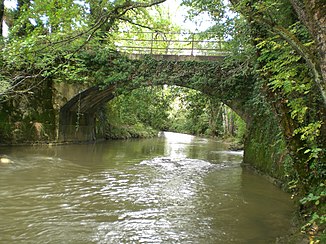Allondon
| Allondon | ||
|
Pont Moulin Fabry |
||
| Data | ||
| Water code | FR : V0410500 , CH : 94 | |
| location | France , Switzerland | |
| River system | Rhone | |
| Drain over | Rhone → Mediterranean | |
| source | in the municipality of Échenevex , France 46 ° 18 ′ 7 ″ N , 6 ° 1 ′ 36 ″ E |
|
| Source height | 580 m | |
| muzzle | near La Plaine, Switzerland, in the Rhone coordinates: 46 ° 10 ′ 38 ″ N , 6 ° 0 ′ 35 ″ E ; CH1903: 489.66 thousand / 114979 46 ° 10 '38 " N , 6 ° 0' 35" O |
|
| Mouth height | 350 m | |
| Height difference | 230 m | |
| Bottom slope | 13 ‰ | |
| length | 18 km | |
| Catchment area | 148 km² | |
| Left tributaries | Lion | |
|
The Allondon meets the Rhone |
||
The Allondon is an approximately 18 km long right tributary of the Rhone . It has its source in France, in the municipality of Échenevex . The mouth is located at La Plaine , in the municipality of Dardagny in Switzerland, west of Geneva . The Allondon drains a section of the Pays de Gex with a catchment area of 148 km², of which 11 km² are on Swiss soil.
geography

The karst spring of the Allondon lies in a wooded valley at 580 m above sea level. M. at the foot of the Jura below the Colomby de Gex near the hamlet of Naz Dessus in the municipality of Echenevex in the French department of Ain . The Allondon flows southward through a notched valley that is slightly cut into the slopes at the foot of the Jura , before entering the Geneva basin, which is characterized by Quaternary deposits.
Shortly before the Allondon reaches the Swiss border , the Lion , the most important tributary , flows from the left . The two rivers generally carry a similar amount of water. The Lion with its source brook Journans (origin in the High Jurassic also on Colomby de Gex), however, has already covered a significantly longer distance of 20 km than the Allondon (8.5 km).
Below Saint-Genis-Pouilly , the Allondon gradually deepens into the surrounding area and initially forms the state border between France and Switzerland for 2 km before it crosses completely into Swiss territory ( canton Geneva ). Here it flows in a valley that is up to 500 m wide and around 50 m sunk into the plateaus of the Geneva Basin, before flowing into the Rhône at La Plaine (municipality of Dardagny ).
In addition to the Lion, the Allemogne and the Roulavaz are important tributaries , both of which drain the steep southeastern slopes of the Jura in the area of its highest elevations of Crêt de la Neige and Reculet .
Hydrology
The Allondon has a nivopluvial runoff regime with strongly fluctuating water levels. Floods can occur in spring during the snowmelt in the Jura and later in the year during strong thunderstorms or prolonged rainfall. With strong floods (for example in February 1990 caused by heavy snowmelt in the Jura in combination with heavy rainfall), discharge rates of more than 100 m³ / s can be achieved. In contrast, the mean flow rate at low water is just 0.6 m³ / s.
natural reserve
The approximately 6 km long Swiss section of the Allondon Valley has been a nature reserve since 1968 and is one of the nature reserves of national importance. The barrel of the Allondon is in its natural state. The entire valley floor is filled with alluvial material from the river, some of which is fortified by bush and forest vegetation. Elsewhere there are large gravel areas. The river, which can largely move freely in the valley floor, shifts its course after every flood, piles up new gravel banks and carries them away again elsewhere.
The Allondon Valley is a popular destination for excursions and a local recreation area for the city of Geneva. Various hiking trails invite you to explore nature.
Flora and fauna
The mild climate and the optimal orientation of the valley (north-south) enabled the development of a partially Mediterranean vegetation. In the valley there are numerous rough meadows with rare plant species, around 20 different orchid species , many sweet chestnuts and robinia. The Allondon itself is rich in fish, with trout and grayling making up the largest populations. The natural river valley offers habitats and hiding places for rare bird species ( kingfisher , dipper , gray wagtail , warbler , willow tit ) and reptiles.
history
The first written mention of the Allondon took place in 1397 under the name Aqua de Alandons ; In the 18th century the name La London appeared on certain maps , and even today the river is sometimes referred to as Allandon on French maps . The name originally comes from pre-Celtic times and means living water .
In the 18th century, the Allondon's hydropower was used to operate a paper mill. At the confluence of the Roulavaz, an asphalt mine was exploited in the 19th century. The project of a reservoir between Dardagny and Russin was abandoned in 1938.
See also
Web links
- River description for water trips ( Memento from February 12, 2013 in the web archive archive.today )

